Konstantin Korovin (Константин Сергеевич Коровин) (1861-1939)
Get a Korovin Certificate of Authenticity for your painting (COA) for your Korovin drawing.
For all your Korovin artworks you need a Certificate of Authenticity (COA) in order to sell, to insure or to donate for a tax deduction.
Getting a Korovin Certificate of Authenticity (COA) is easy. Just send us photos and dimensions and tell us what you know about the origin or history of your Korovin painting or drawing.
If you want to sell your Korovin painting or drawing use our selling services. We offer Korovin selling help, selling advice, private treaty sales and full brokerage.
We have been authenticating Korovin and issuing certificates of authenticity since 2002. We are recognized Korovin experts and Korovin certified appraisers. We issue COAs and appraisals for all Korovin artworks.
Our Korovin paintings and drawings authentications are accepted and respected worldwide.
Each COA is backed by in-depth research and analysis authentication reports.
The Korovin certificates of authenticity we issue are based on solid, reliable and fully referenced art investigations, authentication research, analytical work and forensic studies.
We are available to examine your Korovin painting or drawing anywhere in the world.
You will generally receive your certificates of authenticity and authentication report within two weeks. Some complicated cases with difficult to research Korovin paintings or drawings take longer.
Our clients include Korovin collectors, investors, tax authorities, insurance adjusters, appraisers, valuers, auctioneers, Federal agencies and many law firms.
We perform Konstantin Korovin art authentication, appraisal, certificates of authenticity (COA), analysis, research, scientific tests, full art authentications. We will help you sell your Konstantin Korovin or we will sell it for you.

Konstantin Korovin was a leading Russian Impressionist painter. Konstantin was born in Moscow to a merchant family officially registered as peasants of Vladimir gubernia. His father, Aleksey Mikhailovich Korovin, earned a University degree and was more interested in arts and music than in the family business established by Konstantin’s grandfather. Konstantin’s older brother Sergey Korovin was a notable realist painter. Konstantin’s relative Illarion Pryanishnikov was also a prominent painter of the time and a teacher at the Moscow School of Painting, Sculpture and Architecture.
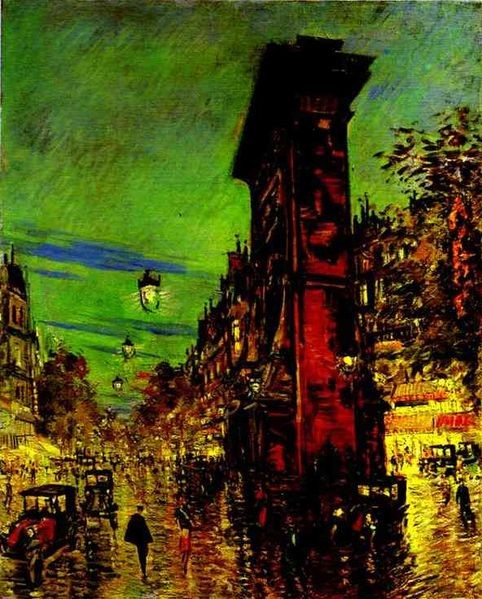
In 1875, Konstantin entered the Moscow School of Painting, Sculpture and Architecture, where he learned from Vasily Perov and Alexei Savrasov. His brother, Sergey was already a student of the School. During their years at the school, the Korovins became friends with their fellow students Valentin Serov and Isaac Levitan. Kontantin remained friends with Serov and Levitan throughout his life.

In 1881-1882, Korovin spent a year at the Imperial Academy of Arts in Saint Petersburg, but returned disappointed to the Moscow School of painting, sculpturing and architecture. He studied at the school under the new teacher Vasily Polenov until 1886. In 1885, Korovin made traveled to Paris and Spain. Paris was a shock for me… Impressionists… in them I found everything for what I was scolded back at home, in Moscow, he later wrote.
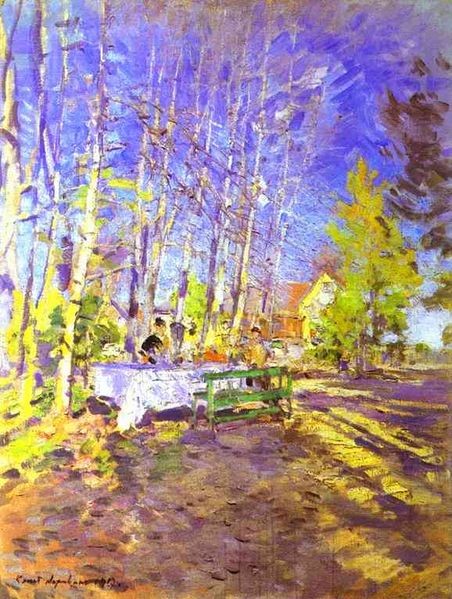
Polenov introduced Korovin to Savva Mamontov’s Abramtsevo circle: Viktor Vasnetsov, Apollinary Vasnetsov, Ilya Repin, Mark Antokolsky and others. The Abramtsevo circle’s love for stilized Russian themes is reflected in Korovin’s picture A Northern Idyll. In 1885 Korovin works for Mamontov’s Opera house. He designed the stage decor for Giuseppe Verdi’s Aida, Léo Delibes’ Lakme and Georges Bizet’s Carmen.
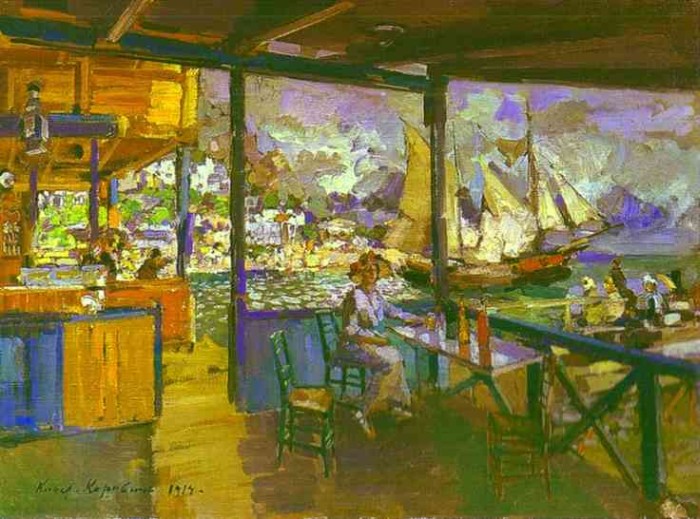
In 1888, Korovin traveled with Mamontov to Italy and Spain, where he produced painting On the balcony, Spanish women Leonora and Ampara. Konstantin traveled within Russia, Caucasus and Central Asia, exhibited with Peredvizhniki. He was painting in the Impressionist and later in the Art Nouveau style.
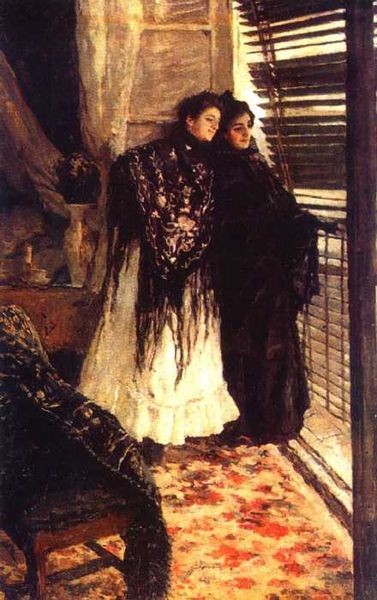
In the 1890s, Korovin became a member of the Mir iskusstva art group. Korovin’s subsequent works was strongly influenced by his travel to the North. In 1888 he was captivated by the stern northern landscapes, as seen in The Coast of Norway and The Northern Sea. His second trip to the North, with Valentin Serov in 1894, coincided with the construction of the Northern Railway. Korovin painted a large number of landscapes: Norwegian Port, Saint Trifon’s Brook in Pechenega, Hammerfest: Aurora Borealis, The Coast at Murmansk and others. The paintings are built on a delicate web of shades of grey. The etude style of these works was typical for the Korovin’s art of the 1890s.
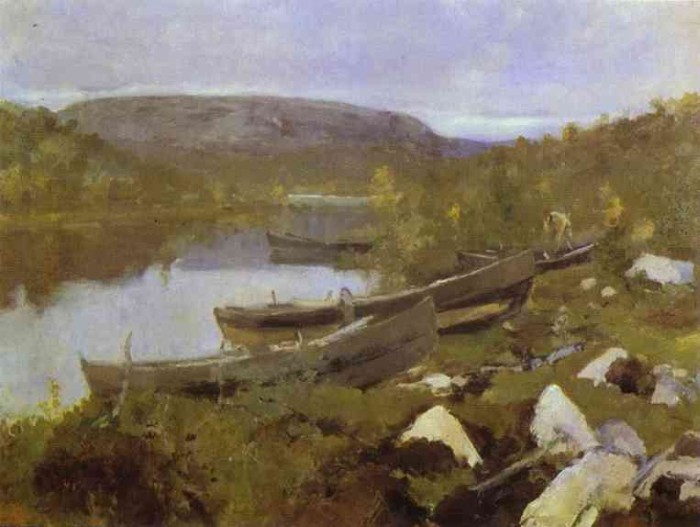
Using material from his northern trip, Korovin designed the Northern Railway pavilion at the All Russia Exhibition of 1896 at Nizhny Novgorod. In 1900, Korovin designed the Central Asia section of the Russian Empire pavilion on the Paris World Fair; and was awarded the Legion of Honour by the French government.
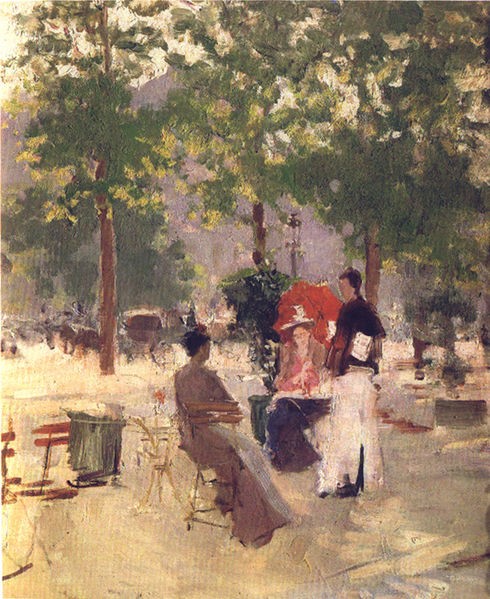
In the beginning of the 20th century Korovin focused his attention on the theatre. He moved from Mamontov’s opera to Mariinsky Theatre in Saint Petersburg. Departing from the tradition of the stage decor, which only indicated the place of action, Korovin produced a mood decor, which conveyed the general emotions of the performance. Korovin designed sets for Konstantin Stanislavski’s drama productions, as well as Mariinsky’s operas and ballets. He did the stage design for such Mariinsky’s productions as Faust (1899), The Little Humpbacked Horse (1901) and Sadko (1906) that became famous for their expressiveness.

In 1905, Korovin became an Academician of Painting, and in 1909-1913 he was a professor at the Moscow School of Painting, Sculpture and Architecture. One of the artist’s favourite themes was Paris. He painted A Paris Cafe (1890s’), Cafe de la Paix (1905′), La Place de la Bastille (1906), Paris at Night; Le Boulevard Italien (1908′), Night Carnival (1901), Paris in the Evening (1907) and others.
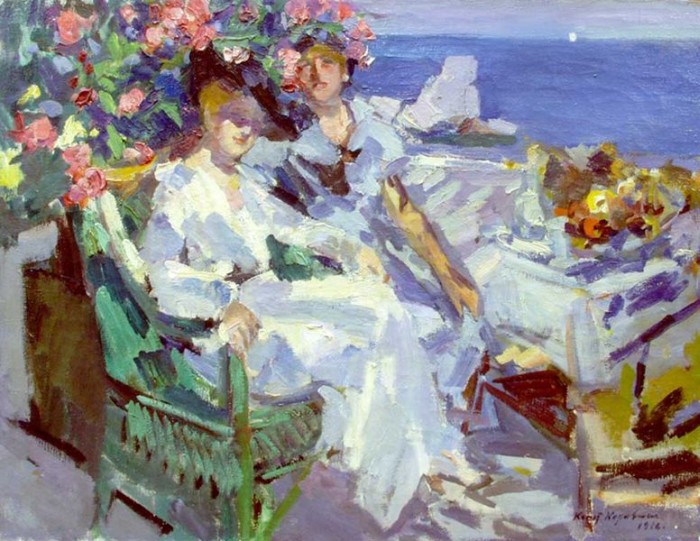
During the World War I Korovin worked as a camouflage consultant at the headquarters of one of the Russian armies and was often seen at the front line. After the October Revolution Korovin continued to work in the theatre, designing stage for Richard Wagner’s Die Walküre and Siegfried as well as Pyotr Ilyich Tchaikovsky’s Nutcracker (1918-1920).

In 1923 Korovin moved to Paris by the advice of the Commissar of Enlightenment, Anatoliy Vasilievich Lunacharsky, to cure his heart condition and help Korovin’s handicapped son. There was supposed to be a large exhibition of Korovin’s works but the works were stolen and Korovin was left penniless. For years produced the numerous Russian winters and Paris boulevards just to make ends meet.

In the last years of his life he produced stage designs for many of the major theatres of Europe, America, Asia and Australia, the most famous of which is his scenery for a production by the Turin Opera House of Nikolai Rimsky-Korsakov’s The Golden Cockerel. Korovin died in Paris on September 11, 1939. Konstantin’s son Alexey Korovin (1897-1950) was a notable Russian-French painter. Because of an accident during his childhood he had both feet amputated. Alexey committed suicide in 1950.
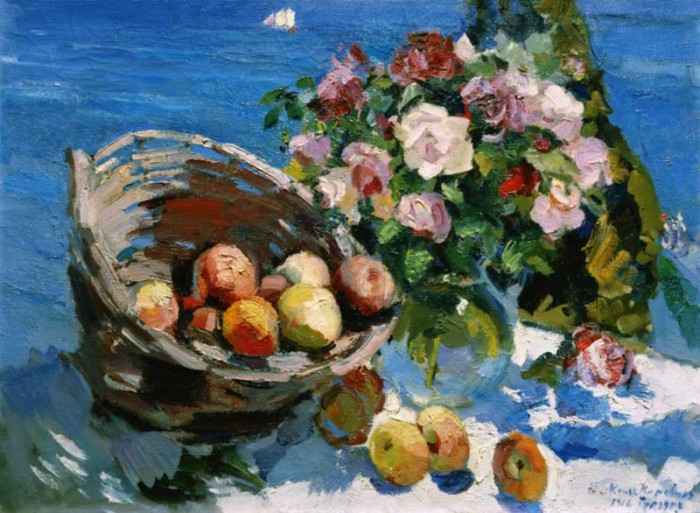
Still wondering about a Russian painting in your family collection? Contact us…it could be by Konstantin Korovin.
Reviews
1,217 global ratings
5 Star
4 Star
3 Star
2 Star
1 Star
Your evaluation is very important to us. Thank you.
